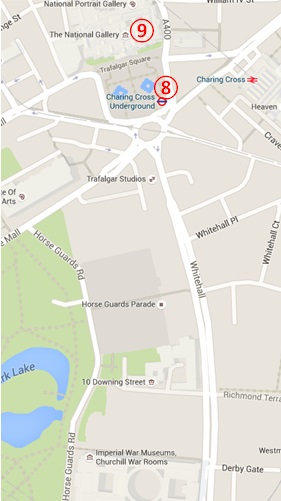Main author
Michael BrooksBuildings of Westminster
Contents |
[edit] The building you can't miss
[edit] 1. Westminster Abbey
As a grandiose mausoleum for England’s historical giants, Westminster Abbey has an overpowering presence on the surrounding area. The origins of the church date back to the time of William the Conqueror, but it was Henry III in 1245 who commissioned the abbey’s reconstruction in the French Gothic style that consciously tried to ape the recently completed Rheims Cathedral. Much the same as the Houses of Parliament, the Gothic Revival front was designed in the early-18th century by Nicholas Hawksmoor.
[edit] The buildings that define the area
[edit] 2. Palace of Westminster
The Palace of Westminster is the symbolic centre of political power in the UK and one of the most recognisable and iconic buildings in the world, used to adorn everything from royal seals to sauce bottles.
Despite the building, with its golden brown turrets, spires and vanes, looking like a centuries-old sand castle, it belies a more surprising truth. The Palace, in its current ramshackle form, actually only dates back to 1870 when it was designed by Charles Barry and Augustin Pugin in a conservative Gothic Revival style. Their aim was to instil in the minds of the British people a sense of heritage and gravitas that could exude executive power as well as legitimise it, and that would reinforce a sense of history.
For more information, see Palace of Westminster.
[edit] 9. National Gallery (see below)
[edit] The buildings that break the rules
[edit] 3. Home Office
Taking a left down Great Smith Street takes you to the building of the Home Office. Constructed in 2005 and designed by Terry Farrell, with its horizontal steel battens and decorative grid pattern, the building looks rather like a giant air-conditioning unit.
[edit] 4. QE2 Centre
Alongside, and overlooked by, Westminster Abbey is the QE2 Exhibition Centre, its modernist edifice a hectic mix of grey concrete and glass.
[edit] The buildings that get overlooked
[edit] 5. St. Thomas' Hospital
St Thomas’ Hospital stands as a rigid and box-like representation of white-tiled clinical functionality.
[edit] 6. Portcullis House
Alongside Big Ben is the parliamentary office building Portcullis House which opened in 2001. It was designed by Michael Hopkins & Partners to represent the chained portcullis symbol of the Houses of Parliament, together with a series of mock chimneys that said to invoke the Gothic Revival of its neighbour.
Jewel Tower
Continuing away from the square along the flank the Palace, leads to Jewel Tower, three-storey crenelated stone remnant of the royal Palace of Westminster, surrounded by a long-dry moat. Used upon construction in 1365 as a stronghold for the treasure of Edward III, the tower is architecturally remarkable for its elaborate vaulting of Kentish Ragstone.
[edit] The surprising building
[edit] 7. Central Hall Westminster
Out from the North-west corner of Parliament Square, is the grand Methodist Central Hall, built in 1912 in the Edwardian Beaux-Arts style. The building was one of the first to use a reinforced concrete frame in Britain, while the self-supporting ferro-concrete dome of the Great Hall is reputed to be the second-largest of its type in the world.
[edit] The oddity
8. UK's smallest police station (see below)
Most people who pose by the fountains and bronze lions of Trafalgar Square are oblivious to an architectural oddity on the south-east corner. This one-man sentry box was installed by Scotland Yard in 1926 and is considered to be the smallest police station in Britain. Masquerading as a lamp post, the hollowed-out granite box with narrow window slits was allegedly intended to serve as a location for police to spy on demonstrators and protesters who would regularly gather on the square.
See also: The Broadway, Westminster.
Featured articles and news
Homes England creates largest housing-led site in the North
Successful, 34 hectare land acquisition with the residential allocation now completed.
Scottish apprenticeship training proposals
General support although better accountability and transparency is sought.
The history of building regulations
A story of belated action in response to crisis.
Moisture, fire safety and emerging trends in living walls
How wet is your wall?
Current policy explained and newly published consultation by the UK and Welsh Governments.
British architecture 1919–39. Book review.
Conservation of listed prefabs in Moseley.
Energy industry calls for urgent reform.
Heritage staff wellbeing at work survey.
A five minute introduction.
50th Golden anniversary ECA Edmundson apprentice award
Showcasing the very best electrotechnical and engineering services for half a century.
Welsh government consults on HRBs and reg changes
Seeking feedback on a new regulatory regime and a broad range of issues.
CIOB Client Guide (2nd edition) March 2025
Free download covering statutory dutyholder roles under the Building Safety Act and much more.
Minister quizzed, as responsibility transfers to MHCLG and BSR publishes new building control guidance.
UK environmental regulations reform 2025
Amid wider new approaches to ensure regulators and regulation support growth.
BSRIA Statutory Compliance Inspection Checklist
BG80/2025 now significantly updated to include requirements related to important changes in legislation.

























